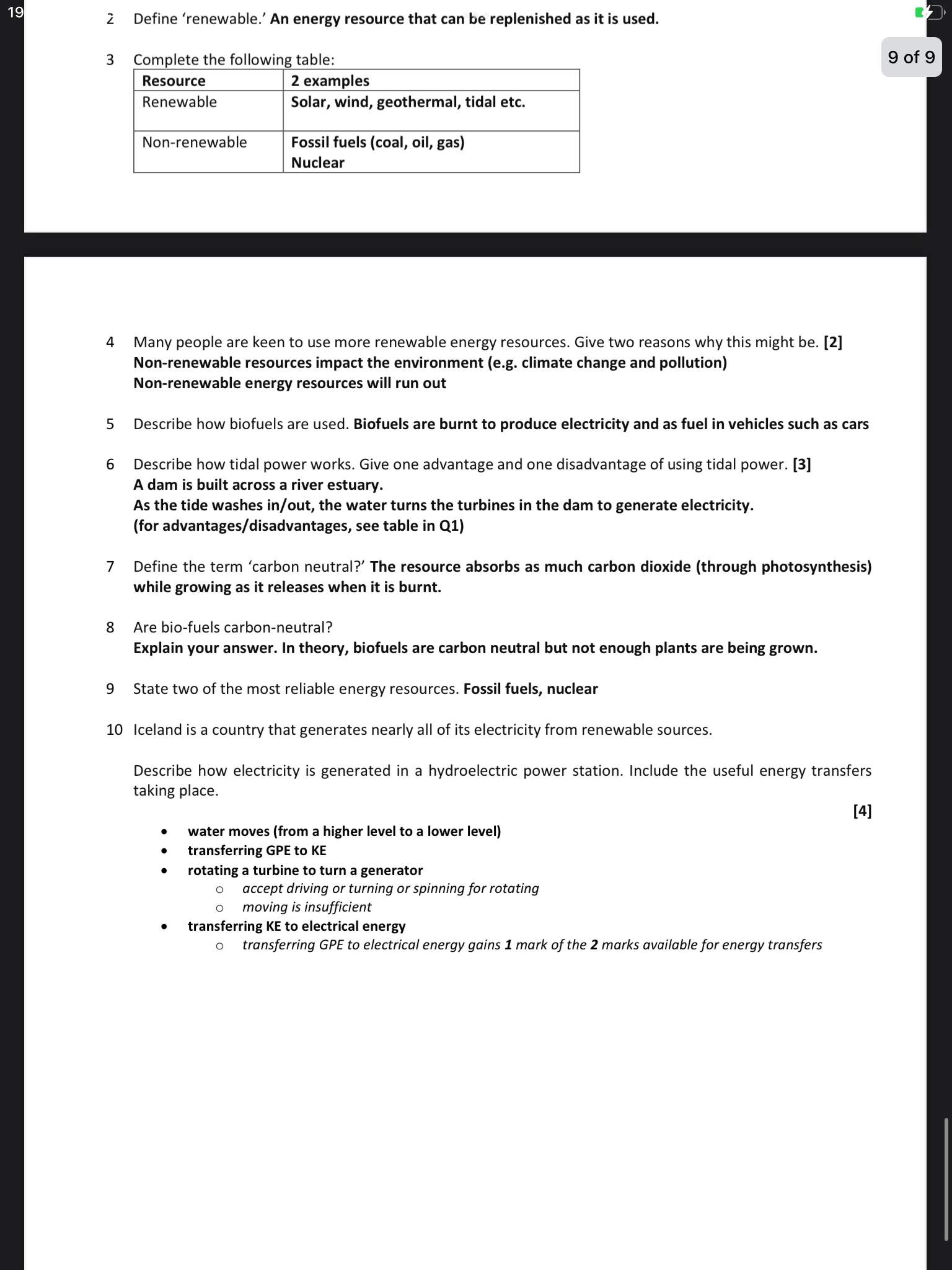Define 'renewable.' Complete the following table: Resource - 2 examples, Renewable - Solar, wind, geothermal, tidal etc.; Non-renewable - Fossil fuels (coal, oil, gas), Nuclear. Ma... Define 'renewable.' Complete the following table: Resource - 2 examples, Renewable - Solar, wind, geothermal, tidal etc.; Non-renewable - Fossil fuels (coal, oil, gas), Nuclear. Many people are keen to use more renewable energy resources. Give two reasons why this might be. Describe how biofuels are used. Describe how tidal power works. Give one advantage and one disadvantage of using tidal power. Define the term 'carbon neutral.' Are biofuels carbon-neutral? State two of the most reliable energy resources. Describe how electricity is generated in a hydroelectric power station. Include the useful energy transfers taking place.

Understand the Problem
The image contains a series of questions regarding energy resources, including definitions, examples, environmental impacts, and energy generation processes. It addresses renewable and non-renewable resources, carbon neutrality, and specifics about hydroelectric power generation.
Answer
Renewable resources, like solar and wind, are replenishable. Biofuels are burned for energy. Tidal power uses tidal movement to spin turbines. Reliable resources include solar and wind. Hydroelectric uses water flow for energy conversion.
- Renewable energy is a resource that can be replenished as it is used. Examples include solar and wind.
- Reasons for using renewable energy: reduces environmental impact, prevents depletion of resources.
- Biofuels are used for generating electricity and as vehicle fuel.
- Tidal power involves building a dam across an estuary; turning turbines as tides move to generate electricity. Advantage: reliable; Disadvantage: environmental impact.
- 'Carbon neutral' means absorbing as much CO2 as emitted. Biofuels can be carbon neutral but may not be due to insufficient plant growth.
- Reliable energy resources: solar, wind.
- In hydroelectric power, water moves from high to low, transferring gravitational potential energy into kinetic, then into electrical energy via turbines.
Answer for screen readers
- Renewable energy is a resource that can be replenished as it is used. Examples include solar and wind.
- Reasons for using renewable energy: reduces environmental impact, prevents depletion of resources.
- Biofuels are used for generating electricity and as vehicle fuel.
- Tidal power involves building a dam across an estuary; turning turbines as tides move to generate electricity. Advantage: reliable; Disadvantage: environmental impact.
- 'Carbon neutral' means absorbing as much CO2 as emitted. Biofuels can be carbon neutral but may not be due to insufficient plant growth.
- Reliable energy resources: solar, wind.
- In hydroelectric power, water moves from high to low, transferring gravitational potential energy into kinetic, then into electrical energy via turbines.
More Information
Biofuels may not be entirely carbon neutral unless their full production cycle balances CO2 emissions. Hydroelectric stations convert water's gravitational energy into electricity, making them a renewable energy wealth.
Tips
Confusing renewable with infinite resources—renewables are replenishable but not limitless without sustainable management.
Sources
- What is renewable energy? | United Nations - un.org
- Renewable Resource: Definition, Considerations, and Examples - investopedia.com
- Renewable Energy: The Clean Facts - NRDC - nrdc.org
AI-generated content may contain errors. Please verify critical information